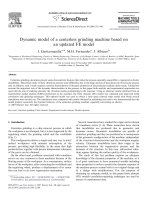Maria et al. International Journal of Emergency Medicine 2011, 4:13 docx
Bạn đang xem bản rút gọn của tài liệu. Xem và tải ngay bản đầy đủ của tài liệu tại đây (539.13 KB, 3 trang )
CAS E REP O R T Open Access
A unique cause of hemoperitoneum:
spontaneous rupture of a splenic
hemangiopericytoma
Picozzi Stefano Carlo Maria
1*
, Massimo Mauri
2
and Luca Carmignani
1
Abstract
Non-traumatic hemoperitoneum may be catastrophic if it is not promptly diagnosed and treated. It is critical to
identify this clinical picture and treat any active bleeding. We report the first case in the literature (to our
knowledge) of spontaneous hemoperitoneum caused by a cystic splenic hemangiopericytoma.
Hemangiopericytomas represent a small subset of soft tissue sarcomas. They rarely originate in the spleen as a
primary tumor, with only ten cases having been previously described. The difficulty of predicting the prognosis
and clinical behavior of these lesions has been repeatedly stressed. The literature concerning this rare and unusual
neoplasm is reviewed.
Introduction
Non-traumatic hemoperitoneum may occur sponta-
neously or may be iatrogenic. This uncommon and often
unsuspected condition may be catastrophic if it is not
promptly diagnosed and treated. The possible causes
include hemorrhage from a highly vascular neoplasm,
pathological splenic rupture, hemorrhage or rupture of
an ovarian cyst, rupture of the gestational sac or other
affected anatomic part in an ectopic pregnancy, bleeding
from a vascular lesion, anticoagulation therapy, blood
dyscrasi as, surgery and invas ive procedures. It is critical
to identify the clinical picture and treat any active bleed-
ing promptly [1]. We report the first case in the literature
(to our know ledge) of spont aneous hemoperito neum
caused by a cystic splenic hemangiopericytoma.
Case Report
A 70-year-old man was admitted to our Urology Depart-
ment with a 2-month history of left-sided abdominal
pain. There was no significant past medical or family
history. Previous ultrasonography h ad shown a 10-cm
cystic lesion of the spleen and left hydronephrosis, and
a further contrast-enhanced computer tomography e va-
luation confirmed a 12-cm cystic lesion located at the
upper pole of the spleen suspected to be a hemorrhagic
cyst and a suspected urothelial lesion of the pelvic
ureter causing hydronephrosis.
An electrocardiogram performed a t admission docu-
mented an unknown atrial fibrillation with high ventri-
cular response. The patient began pharmacological
cardioversion with amiodarone, beta-blocking therapy in
order to slow the heart rate, and anticoagulation therapy
with enoxaparin 12,000 IU/day.
Two days later, the patient developed two episodes of
nausea, vomiting, confusion, and sweating associated
with abdominal discomfort. The general examination
was normal except for pallor, and his hemodynamic
parameters were stable with a blood pressure of 110/80
mmHg, pulse of 70/min, and O2 saturation of 99% on
room air. Blood tests revealed that his hemoglobin had
dropped to 10.2 g/dl from the initial value of 14.5 g/dl.
Urgent ultrasonography and computed tomography
showed active bleeding in the splenic cystic lesion asso-
ciated with signs o f a recent massive hemorrhage and
hemoperitoneum (Figure 1). The patient ’scondition
worsened, and supportive therapy with monitoring was
initiated. Central venous access was established in addi-
tion to two large-bore catheters in peripheral lines.
Fluid resuscitation was initiated with repeated aliquots
of 250 ml of Ringer’s solution and 6% hydroxyethyl
starch 130/0.4 in 0.9% sodium chloride solution, admi-
nistered with continuous monitoring: systolic b lood
* Correspondence:
1
Urology Department, IRCCS Policlinico San Donato, University of Milan, Via
Morandi 30, San Donato Milanese, 20097, Milan, Italy
Full list of author information is available at the end of the article
Maria et al. International Journal of Emergency Medicine 2011, 4:13
/>© 2011 Maria et al; licen see Springer. This is an Open Access article distributed under the terms of the Creative Commons Attribution
License (http://c reativecommons.org/licenses/by/2.0), which permits unrestricted use, distribution, and reproduction in any medium,
provided the original work is properly cited.
pressure recovered to 90 mmHg and the radial pulse
reappeared.
After stabilization, an emergent exploratory laparot-
omy was performed, and 3,500 ml of blood was evacu-
ated from the peritoneal cavity. The preoperative
hemoglobin was 7.0 g/dl. At surgery, the cystic lesion
located at the upper pole of the spleen was found to
have ruptured and to be adherent to the diaphragm,
colon, and lateral abdominal wall. After splenectomy
with excision of the cystic lesion, a drain was inserted
and the wound closed. The patient’s hemodynamic con-
ditions remained stable, and he was transferred to the
intensive care unit where he received a total of 5 units
of packed red blood cells and 2 units of fresh-frozen
plasma. The postoperative recovery was uneventful. His-
tological examination of the cystic lesion showed that it
was a splenic hemangiopericytoma.
At the 12-month follow-up, computed tomography
revealed recurrence of the lesion at the greater omen-
tum, splenic flexure, and stomach. An exploratory lapar-
otomy c onfirmed the radiological findings, and the
greater omentum and lesions were excised.
Discussion
Hemangiopericytomas constitute a small subset of soft
tissue sarcomas. They were first named by Stout and
Murray in 1942, and described as distinct vascular soft
tissue tumors characterized by groups of endothelial-
lined tubes and sprouts, featuring Zimmerman’speri-
cytes [2,3]. Only recently, evolving histopathological
concepts and the new 2006 WHO classification of soft
tissue sarcomas abandoned this previous vision of a
pericyte-derived tumor in favor of a fibroblastic cell ori-
gin, integrating this lesion into the family of solitary
fibrous tumors [3].
These neoplasms primarily affe ct adults aged between
20 and 70 years old, with the median age in the 40 s
and 50 s. Males and females are affected equally [3-6].
The most common anatomic locations are the lower
limbs, axilla, retroperitoneum, pelvic fossa, and head
and neck, although hemangiopericytomas have also been
described in many o ther locations such as the lung,
breast, perito neum, liver, pancreas, sto mach, greater
omentum, mediastinum, bone, inguinal region, uterus,
ovary, and vagina [7]. Hemangiopericytomas rarely origi-
nate in the spleen as a primary tumor (only ten cases
have been described in the international literatu re), and
this presentation was first reported by Guadalajara Jur-
ado et al. in 1989 [8-16]. Splenic hem angiopericytoma is
typically asymptomatic and results in splenomegaly.
There may be single or multifocal lesions. Given their
hypervascular nature, expansive growth, change in the
structure of the vessel walls, erosion and necrosis, these
lesions can bleed.
Macroscopically, the tumor appears sof t and rubbery,
and is encapsulated. The average size of such tumors is
6.5 cm [5]. Microscopically, hemangiopericytomas are
characterized by well-developed, branching, “stag-horn,”
thick-walled vessels surrounded by a connective tissue
sheath, moderate-to-high cellularity, and a monotonous
appearance under light microscopy examination [3].
Imaging studies show a rounded, sharply outlined mass
of homogenous density. The typical ultrasonographic
picture is a mass with clearly defined margins and a het-
erogeneous echo pattern that is highly vascularized on
color Doppler [17].
On computed tomography, the lesion appears as a
well-demarcated, highly vascularized soft tissue mass
that can displace adjacent organs [7]. Cystic areas of low
attenuation, consistent with necrosis, calcifications,
which are freque nt in large lesions, and invasion of sur-
rounding structures can be present and are suggestive of
a malignant form. Despite improvements in imaging
techniques, the differential diagnosis and management
of splenic hemangi opericytoma are problem atic because
of the rarity of the disease. Staging studies include chest,
abdominal, and pelvic computed tomography.
The difficulty of predicting the prognosis and clinical
behavior of hemangiopericytomas has been repeatedly
stressed in the literature. Certain characteristics of the
tumor, such as large size (>5 cm), a high number of
mitotic figures (>4 mitoses/10 high-powered field), cel-
lular atypia, presence of necrosis, and/or hemorrhage
can help to different iate the malignant form from the
benign form [3,5]. The reported rate of metastasis varies
significantly from 10 to 60% [3,5,6,18,19]. The pattern of
malignant spread is principally hematogenous to the
lung, bone, and liver, while lymphatic metastases are
uncommon.
Figure 1 Abdominal computed tomography scans showing
active bleeding in the splenic cystic lesion associated with
signs of a recent massive hemorrhage and hemoperitoneum.
Maria et al. International Journal of Emergency Medicine 2011, 4:13
/>Page 2 of 3
Surgical resection, ideally with negative microscopic
margins, is the treatment of choice. Local recurrence s
have been reported in one-third of patients [6]. Oncolo-
gical treatment standards are hampered by organotropic
hemangiopericytomas that mimic benign forms or
require emergency operations for bleeding. Radiotherapy
reduces local recurrences, as shown for other soft tissue
sarcomas, while the role of adjuvant chemotherapy is
controversial. The management of local recurrences and
metastatic disease is challenging, because no clearly
effective therapy exists. In particular, hemangiopericy-
toma originating in the abdomen behaves aggressively
and a careful, life-long follow-up is required for patients
bec ause recurrence and metastases can develop after an
extended disease-free period.
Written infor med consent was obtained from the
patient for publication of this case report and accompa-
nying images. A copy of the written consent is available
for review by the Editor-in-Chief of this journal.
Acknowledgements
There are no acknowle dgements and no previous reports that might be
regarded as redundant publication of the same work.
Author details
1
Urology Department, IRCCS Policlinico San Donato, University of Milan, Via
Morandi 30, San Donato Milanese, 20097, Milan, Italy
2
I Surgery Department,
IRCCS Policlinico San Donato, University of Milan, Via Morandi 30, San
Donato Milanese, 20097, Milan, Italy
Authors’ contributions
The manuscript has been read and approved by all the authors, the
requirements for authorship have been met, and each author believes that
the manuscript represents honest work.
Competing interests
Financial or other relationships that might lead to a conflict of interest:
none.
Received: 29 January 2011 Accepted: 5 April 2011
Published: 5 April 2011
References
1. Lubner M, Menias C, Rucker C, Bhalla S, Peterson CM, Wang L, Gratz B:
Blood in the belly: CT findings of hemoperitoneum. Radiographics 2007,
27:109-25.
2. Stout AP, Murray MR: Hemangiopericytoma: a vascular tumor featuring
Zimmermann’s pericytes. Ann Surg 1942, 116:26-33.
3. Park MS, Araujo DM: New insights into the hemangiopericytoma/solitary
fibrous tumor spectrum of tumors. Curr Opin Oncol 2009, 21:327-31.
4. Stout AP: Hemangiopericytoma; a study of 25 cases. Cancer 1949,
2:1027-54.
5. Enzinger FM, Smith BH: Hemangiopericytoma. An analysis of 106 cases.
Hum Pathol 1976, 7:61-82.
6. Choi YJ, Hwang TK, Kang SJ, Kim BK, Shim SI: Hemangiopericytoma of
renal sinus expanding to the renal hilum: an unusual presentation
causes misinterpretation as transitional cell carcinoma. J Korean Med Sci
1996, 11:351-5.
7. Spitz FR, Bouvet M, Pisters PW, Pollock RE, Feig BW: Hemangiopericytoma:
a 20-year single-institution experience. Ann Surg Oncol 1998, 5:350-5.
8. Koch M, Nielsen GP, Yoon SS: Malignant tumors of blood vessels:
angiosarcomas, hemangioendotheliomas, and hemangioperictyomas.
J Surg Oncol 2008, 97:321-9.
9. Ciftci AO, Gedikoğlu G, Firat PA, Senocak ME, Büyükpamukçu N: Childhood
splenic hemangiopericytoma: a previously unreported entity. J Pediatr
Surg 1999, 34:1884-6.
10. Neill JS, Park HK: Hemangiopericytoma of the spleen. Am J Clin Pathol
1991, 95:680-3.
11. Ferrozzi F, Catanese C, Campani R: Splenic hemangiopericytoma: features
with computerized tomography in two cases. Radiol Med 1998, 95:122-4.
12. Hallén M, Parada LA, Gorunova L, Pålsson B, Dictor M, Johansson B:
Cytogenetic abnormalities in a hemangiopericytoma of the spleen.
Cancer Genet Cytogenet 2002, 136:62-5.
13. Guadalajara Jurado J, Turégano Fuentes F, García Menendez C, Larrad
Jiménez A, López de la Riva M: Hemangiopericytoma of the spleen.
Surgery 1989, 106:575-7.
14. Hosotani R, Momoi H, Uchida H, Okabe Y, Kudo M, Todo A, Ishikawa T:
Multiple hemangiopericytomas of the spleen. Am J Gastroenterol 1992,
87:1863-5.
15. Gilsanz C, Garcia-Castaño J, Villalba MV, Vaquerizo MJ, Lopez de la Riva M:
Splenic hemangiopericytoma. Presse Med 1995, 24:1316.
16. Yilmazlar T, Kirdak T, Yerci O, Adim SB, Kanat O, Manavoglu O: Splenic
hemangiopericytoma and serosal cavernous hemangiomatosis of the
adjacent colon. World J Gastroenterol 2005, 11 :4111-3.
17. Goldman SM, Davidson AJ, Neal J: Retroperitoneal and pelvic
hemangiopericytomas: clinical, radiologic, and pathologic correlation.
Radiology 1988, 168:13-7.
18. Pandey M, Kothari KC, Patel DD: Haemangiopericytoma: current status,
diagnosis and management. Eur J Surg Oncol 1997, 23:282-5.
19. Espat NJ, Lewis JJ, Leung D, Woodruff JM, Antonescu CR, Shia J,
Brennan MF: Conventional hemangiopericytoma: modern analysis of
outcome. Cancer 2002, 95:1746-51.
doi:10.1186/1865-1380-4-13
Cite this article as: Maria et al.: A unique cause of hemoperitoneum:
spontaneous rupture of a splenic hemangiopericytoma. International
Journal of Emergency Medicine 2011 4:13.
Submit your manuscript to a
journal and benefi t from:
7 Convenient online submission
7 Rigorous peer review
7 Immediate publication on acceptance
7 Open access: articles freely available online
7 High visibility within the fi eld
7 Retaining the copyright to your article
Submit your next manuscript at 7 springeropen.com
Maria et al. International Journal of Emergency Medicine 2011, 4:13
/>Page 3 of 3









